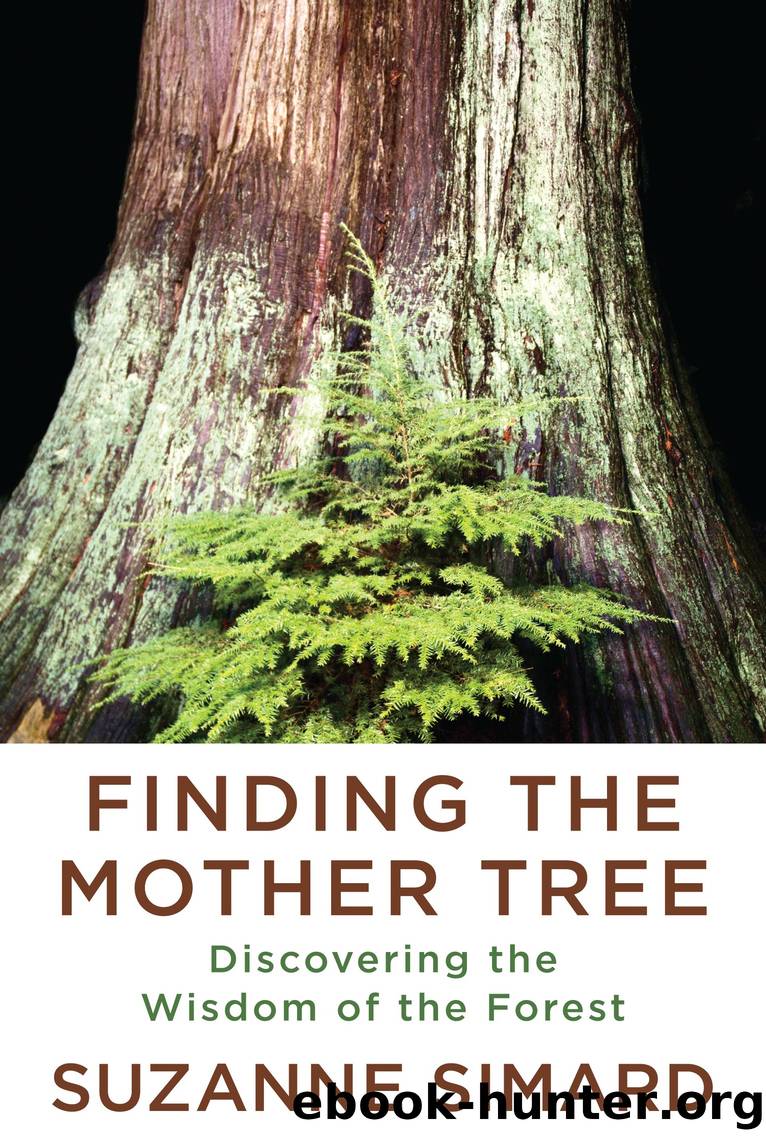Finding the Mother Tree by Suzanne Simard

Author:Suzanne Simard [Simard, Suzanne]
Language: eng
Format: epub
Publisher: Knopf Doubleday Publishing Group
Published: 2021-05-04T00:00:00+00:00
* * *
â
In spite of my breakthroughsâthat trees really are dependent on their connection to the soil and to one anotherâthe thing I most wanted was to talk to, commune with, heal with Kelly. I remembered huckleberry picking once in our grandparentsâ yard when we were little, when he was upset that a bug got into the pail with his two huckleberries. âGet ee out, Gumpa,â heâd begged, panicky. I daydreamed about him standing in Grannieâs garden, holding the biggest tomato. I pictured us fishing for minnows off the dock with rods weâd made from willow shoots. Slip-sliding over rolling logs on searing summer days in the cold waters of the Arrow Lakes. Canoeing across the North Thompson River to ride Mieko through the corn rows and cottonwoods.
The next spring, I made a garden.
Not any old garden, but one based on the discoveries I had been making when he died. One where the plants could share resources and lean on one another. Where they werenât planted in rows, each isolated from the next, but mixed so they could communicate. Care for one another. I followed the âthree-sistersâ technique developed by the Native Americans, who grow corn, squash, and beans as companions to enhance the growth of them all.
Iâd always made a row for each vegetable in my tiny patch of garden soil. But this year, I built mounds of rich earth spaced about a foot apart, molding each into a bowl as though I were a potter, to keep the water from trickling away, as Grannie Winnie had shown me. I planted a seed of each of the three sisters in every mound and watered them daily, and after a week, tiny cotyledons emerged from the black grains.
Garden plants usually associate with arbuscular mycorrhizal fungi, unlike the ectomycorrhizal fungi on most trees. There are only a couple hundred arbuscular mycorrhizal species worldwide, compared to the thousands of ectomycorrhizal species. These arbuscular mycorrhizal fungi are generalists, meaning that even the few species that exist in nature can colonize the roots and should link most of the garden vegetable plants. Like corn, squash, beans, peas, tomatoes, onions, carrots, eggplant, lettuce, garlic, potatoes, yams.
Within weeks of emergence, the roots of my plants were mycorrhizal, tied together. I pulled up a bean and saw tiny white nodules along its length, housing nitrogen-fixing bacteria. The beans were transforming the nitrogen and adding it to the mound of soil shared with the corn and squash. The corn returned the favor by providing a structure for the beans to climb. The squash served as mulch, keeping the soil moist and the weeds and bugs down.
I imagined how the mycorrhizal network played a part in this dance, my gardenâs network shuttling nitrogen from the nitrogen-fixing beans to the corn and squash. And the tall, sunny corn transmitting carbon to the beans and squash it was shading. And the squash sending the water it had saved to the thirsty corn and beans.
My garden thrived.
I could feel forgiveness.
I started clearing trails through the forest surrounding our house.
Download
This site does not store any files on its server. We only index and link to content provided by other sites. Please contact the content providers to delete copyright contents if any and email us, we'll remove relevant links or contents immediately.
Sapiens: A Brief History of Humankind by Yuval Noah Harari(13036)
The Tidewater Tales by John Barth(12025)
Do No Harm Stories of Life, Death and Brain Surgery by Henry Marsh(6332)
Mastermind: How to Think Like Sherlock Holmes by Maria Konnikova(6224)
The Thirst by Nesbo Jo(5778)
Why We Sleep: Unlocking the Power of Sleep and Dreams by Matthew Walker(5636)
Sapiens by Yuval Noah Harari(4528)
Life 3.0: Being Human in the Age of Artificial Intelligence by Tegmark Max(4492)
The Longevity Diet by Valter Longo(4443)
The Rules Do Not Apply by Ariel Levy(3897)
The Immortal Life of Henrietta Lacks by Rebecca Skloot(3820)
The Body: A Guide for Occupants by Bill Bryson(3788)
Why We Sleep by Matthew Walker(3767)
Animal Frequency by Melissa Alvarez(3749)
Yoga Anatomy by Kaminoff Leslie(3696)
Barron's AP Biology by Goldberg M.S. Deborah T(3627)
The Hacking of the American Mind by Robert H. Lustig(3575)
All Creatures Great and Small by James Herriot(3506)
Yoga Anatomy by Leslie Kaminoff & Amy Matthews(3392)
